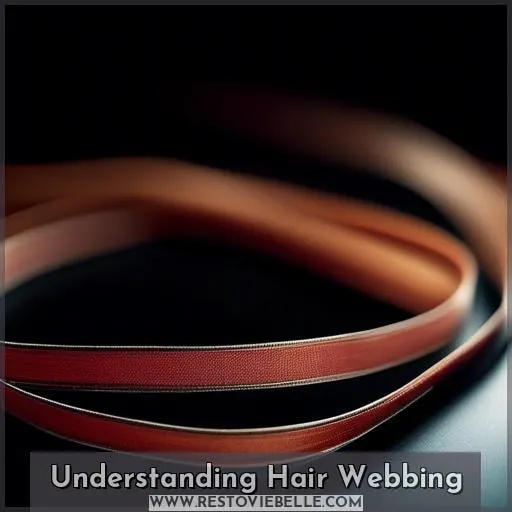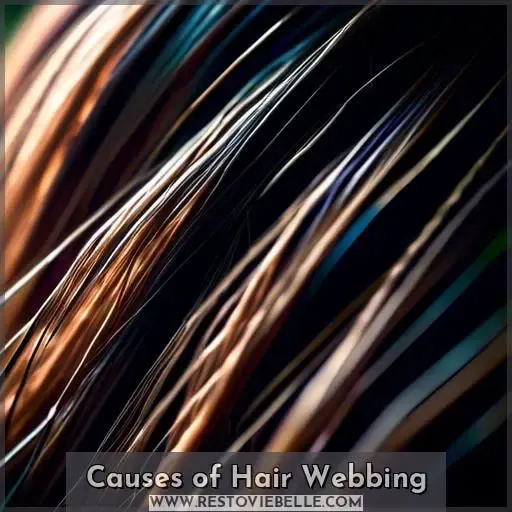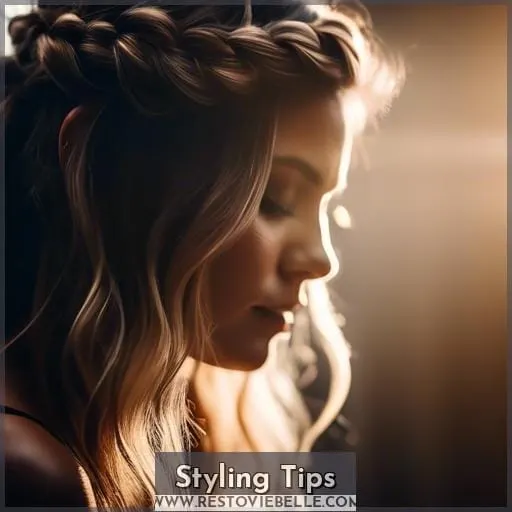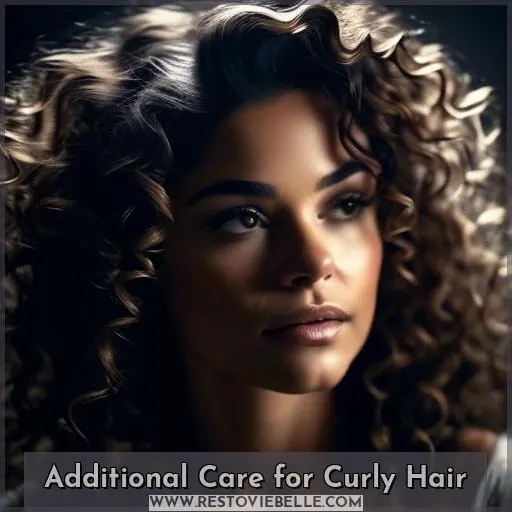This site is supported by our readers. We may earn a commission, at no cost to you, if you purchase through links.
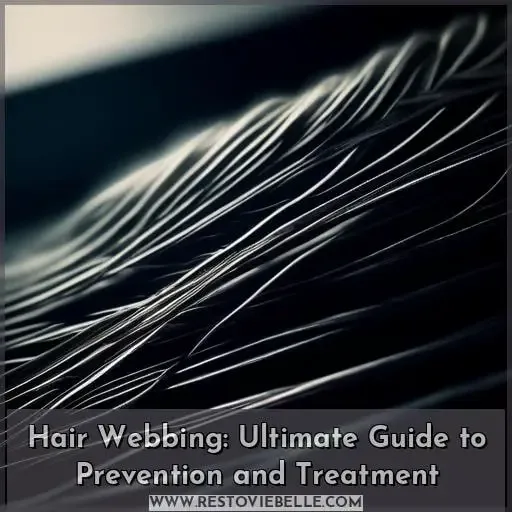 Imagine your hair as a delicate fabric, intricately woven yet prone to tangling into an unwanted tapestry.
Imagine your hair as a delicate fabric, intricately woven yet prone to tangling into an unwanted tapestry.
This phenomenon, known as hair webbing, occurs when individual strands intertwine and stick together, creating a web-like mess. It’s a common challenge, especially for those with finer or curly hair, where dryness and damage leave the cuticle vulnerable.
But fear not, as this guide will arm you with the knowledge to prevent and treat hair webbing. From understanding its causes to exploring hydration techniques and styling tips, you’ll learn how to maintain your hair’s health and beauty, ensuring it flows freely, untangled from the webs that once held it captive.
Table Of Contents
- Key Takeaways
- Understanding Hair Webbing
- Causes of Hair Webbing
- Prevention Strategies
- Treatment Options
- Styling Tips
- When to Consult a Professional
- Additional Care for Curly Hair
- Frequently Asked Questions (FAQs)
- How does hair texture influence the likelihood and severity of hair webbing?
- Can dietary changes or supplements help in reducing the occurrence of hair webbing?
- Is there a genetic predisposition to hair webbing, and how can it be identified?
- How does the water quality (hard vs. soft water) affect hair webbing, and are there any preventive measures?
- Can hormonal changes, such as those during pregnancy or menopause, exacerbate hair webbing, and what are the recommended management strategies?
- Conclusion
Key Takeaways
- Hair webbing is a condition where hair strands stick together, forming web-like tangles, often due to moisture imbalance, cuticle damage, and product overload, particularly affecting those with fine hair strands.
- Common causes of hair webbing include hair dryness, chemical treatments, styling damage, and environmental factors.
- To prevent hair webbing, it is recommended to hydrate and moisturize the hair with deep conditioning treatments, use gentle detangling techniques, and employ protective styling methods such as braids and twists.
- Treatment options for hair webbing involve using clarifying shampoos to remove buildup, deep conditioning to replenish moisture, and regular trimming to eliminate split ends and prevent further tangling.
Understanding Hair Webbing
Hair webbing is a common issue that can affect anyone, but it’s especially prevalent in those with fine or curly hair.
This condition occurs when individual hair strands stick together, forming tangles that resemble a spider web.
Understanding the causes and characteristics of hair webbing is crucial for effectively preventing and treating it, ensuring your hair remains healthy and manageable.
Definition
Hair webbing is a common issue where your strands stick together, forming tangles that resemble a spider web. This can be due to various factors, including genetic predisposition, product incompatibility, hormonal imbalances, scalp conditions, and hair porosity.
If you have natural hair, you might find detangling hair particularly challenging when webbing occurs. To prevent hair tangles and the need for protective styling, it’s essential to understand the causes and implement proper hair care routines.
Characteristics
Hair webbing is a condition where hair strands stick together, creating a tangled, web-like appearance. This issue primarily arises from a lack of moisture, leading to the hair cuticle not flattening as it should.
As a result, individual hairs begin to cling to each other, forming a matrix that resembles a spider web. This condition is particularly common among individuals with naturally curly hair, who may find it a recurring challenge.
- Moisture Imbalance: The root cause of hair webbing is an imbalance in moisture retention, leading to dryness and the hair cuticles not laying flat.
- Cuticle Damage: Damaged hair cuticles contribute to the problem, as they fail to protect the hair shaft adequately, exacerbating tangling and webbing.
- Product Overload: Excessive use of hair products can lead to buildup, further preventing moisture penetration and contributing to the tangled, web-like appearance.
Fine hair strands are especially susceptible to webbing due to their smaller diameter, making them more prone to dehydration and damage from styling and environmental factors. Understanding these characteristics is crucial for addressing hair webbing effectively, ensuring that treatments target the underlying causes, such as improving hydration and reducing product buildup.
Causes of Hair Webbing
Hair webbing is a condition that can significantly affect the health and appearance of your hair, primarily caused by a lack of moisture.
This lack of hydration prevents the hair cuticle from laying flat, leading to individual strands sticking together and tangling, resembling a spider web.
It’s particularly common in people with finer hair strands due to their cuticle’s susceptibility to dryness and damage.
Hair Dryness
Continuing from the importance of understanding hair webbing, let’s delve into one of its primary causes: hair dryness.
Your hair’s health can be compromised by frequent hair brushing and blow drying, which strip away moisture. To combat this, consider reducing heat styling and increasing water intake to maintain hydration.
Product accumulation can also lead to dryness, necessitating a deep clean with clarifying shampoo. Incorporate hair masks into your routine for deep conditioning, which replenishes moisture and promotes hair health.
Chemical Treatments
Continuing from the challenges of hair dryness, chemical treatments are another culprit behind hair webbing. These treatments can strip your hair of its natural oils, leading to chemical damage and hair breakage.
Over time, the harsh chemicals can cause the hair cuticle to lift, making strands prone to tangling and matting. To combat this, it’s essential to incorporate hair repair strategies into your routine. Protective styles like braids can help minimize damage, while using the right hair products can prevent further harm.
Limiting heat styling and embracing protective hairstyles can also shield your hair from UV damage and product buildup, ensuring your locks remain healthy and web-free.
Styling Damage
Continuing from the impact of chemical treatments, styling damage is another significant cause of hair webbing. Your daily styling routine can inadvertently contribute to this frustrating condition.
- Heat Tools: Frequent use of blow dryers, flat irons, or curling wands can strip your hair of moisture, raising the cuticle and leading to tangled hair.
- Brushing Habits: Over-brushing or using the wrong tools can cause hair knots, especially when hair is dry or not properly lubed up with a detangling spray.
- Sun Damage: Prolonged exposure to UV rays can degrade hair porosity and elasticity, making stretched hair more susceptible to webbing.
Trimming your hair regularly can help prevent split ends that contribute to webbing, and adopting gentle styling practices is key to keeping your hair healthy and manageable.
Environmental Factors
As you’ve learned about the damage styling can do, it’s also crucial to consider environmental factors that contribute to hair webbing.
Sun damage can strip your hair of moisture, leading to dryness and tangling. Chlorine exposure from swimming pools and salt water from the ocean can also have a drying effect, exacerbating the webbing of your strands.
Wind damage, often overlooked, can tangle your hair, while heat damage from the sun’s rays can weaken the hair cuticle.
To protect your hair, cover it when outdoors, use protective sprays, and rinse after swimming to mitigate these environmental risks.
Prevention Strategies
To prevent hair webbing, it’s essential to keep your locks well-hydrated and moisturized.
You’ll want to adopt gentle detangling methods, working from the ends up to the roots to minimize breakage.
Additionally, protective styling can help maintain hair health and prevent tangles that lead to webbing.
Hydration and Moisturizing
Continuing from the causes of hair webbing, it’s clear that maintaining proper hydration is key to preventing this issue. To keep your hair from sticking and tangling, you’ll want to incorporate deep conditioning into your routine.
This not only replenishes moisture but also aids in detangling. Look for moisturizing products that contain hair humectants, which are ingredients designed to draw moisture into the hair shaft and help with water retention.
When applying these products, focus on hydration techniques that don’t weigh down your hair. For instance, using a leave-in conditioner with lightweight humectants can provide moisture without leaving a heavy residue.
Additionally, regular use of a deep conditioning treatment can significantly improve your hair’s hydration levels, making it more manageable and less prone to webbing. Remember, the goal is to achieve a balance where your hair retains the right amount of moisture without becoming overly saturated or greasy.
Gentle Detangling Techniques
Continuing from the importance of hydration and moisturizing, let’s delve into gentle detangling techniques.
Start by selecting the right detangling tools, such as wide-toothed combs or specialized detangling brushes.
Before you begin, apply detangling sprays or conditioners to provide slip and reduce friction, making the process smoother.
Always detangle from the ends and work your way up to the roots, which helps prevent unnecessary stress on the hair. Gentle brushing in this manner can help maintain the integrity of your strands and keep them free from knots.
Protective Styling
To shield your hair from damage and maintain its health, consider adopting protective hairstyles. These styles, such as braids or twists, not only minimize exposure to harmful elements but also help retain moisture.
When choosing protective styles, it’s essential to use detangling methods that are gentle on your hair to prevent further damage. Incorporate leave-in conditioners into your routine to provide additional hydration and make detangling easier.
Satin accessories, like pillowcases or headscarves, can also play a crucial role in reducing friction and preventing hair breakage while you sleep.
Treatment Options
When tackling hair webbing, a condition characterized by tangled and intertwined hair strands, it’s essential to focus on effective treatment strategies.
Starting with a clarifying shampoo can help remove buildup that contributes to webbing, restoring cleanliness and balance to your hair.
Following up with a deep conditioning treatment replenishes moisture and aids in detangling, making your hair more manageable.
Regular trimming is also crucial to eliminate split ends and prevent further tangling, ensuring your hair remains healthy and webbing-free.
Clarifying Shampoo
To combat hair webbing and its associated issues like product buildup and scalp health, incorporating a clarifying shampoo into your hair care routine can be a game-changer.
This specialized shampoo acts as a detox, deeply cleansing your hair and scalp to remove stubborn residue that regular shampoos can’t tackle. It’s particularly beneficial for those with low hair porosity, as it helps to prevent the greasy residue that can occur when products sit on the hair rather than being absorbed.
By using a clarifying shampoo, you can also improve hair porosity, allowing for better absorption of moisturizing products, which in turn can help reduce hair breakage. Remember, while clarifying shampoos are powerful, they should be used sparingly to avoid over-drying your hair.
Deep Conditioning
After using a clarifying shampoo to remove buildup, it’s time to focus on deep hydration with a deep conditioning treatment.
- Choose a deep conditioner that suits your hair type, ensuring it contains emollients and humectants like shea butter or honey for maximum product benefits.
- Apply the conditioner generously, focusing on the ends where damage is most prevalent, and use the right application methods to ensure even coverage.
- Manage your time effectively by leaving the deep conditioner in for the recommended duration, usually 20-30 minutes, and consider using heat protection like a heat cap to enhance the treatment’s effectiveness.
Regular Trimming
Regular trims are a cornerstone of hair maintenance, crucial for split end prevention and overall damage control.
To keep your locks looking their best, establish a haircut frequency that aligns with your hair’s needs. For instance, if you’re grappling with split ends, consider trimming every six to eight weeks.
Trim techniques vary, but the goal remains the same: to snip away the damaged tips before they exacerbate the problem.
By incorporating regular cuts into your hair care routine, you’re taking a proactive step towards healthier, more manageable tresses. Remember, consistent trims are an investment in the long-term vitality of your hair.
Styling Tips
When it comes to styling your hair to prevent webbing, it’s essential to avoid tight hairstyles that can exacerbate the issue.
Instead, opt for protective styles like braids or twists that keep your hair stretched and less prone to tangling.
Incorporating leave-in products can help maintain moisture and reduce friction, which is also minimized by using silk or satin accessories like pillowcases.
These simple changes in your hair care routine can significantly impact the health and manageability of your hair.
Avoiding Tight Hairstyles
To keep your hair free from webbing, consider these styling tips:
- Swap tight hairstyles for protective braids, giving your strands a break.
- Before styling, apply a detangling spray to ease combing with a wide-toothed comb.
- Nightly, switch to a silk pillowcase to minimize friction and tangles.
- Use a leave-in conditioner regularly to maintain moisture and prevent knots.
Using Leave-in Products
Incorporating leave-in conditioners into your hair care routine can be a game-changer, especially if you’re dealing with hair webbing. These products are designed to add extra hydration and make your hair more manageable.
When selecting the best leave-in products, consider your hair type. Fine hair benefits from lightweight formulas, while curly or damaged hair may need richer, nutrient-dense options.
DIY leave-in treatments can also be a cost-effective alternative, using natural ingredients like aloe vera gel and coconut water for hydration. For curly hair, leave-in serums or creams that define and hydrate curls without weighing them down are ideal.
Remember, the key is to apply leave-in conditioners to damp hair, focusing on the mid-lengths to ends, and adjust the amount based on your hair’s texture and volume. With patience and the right leave-in for curly hair, you can keep your locks looking healthy and free from tangles.
Silk or Satin Accessories
Switching to silk or satin accessories can make a significant difference in your hair’s health and appearance. These materials are gentle on your hair, reducing friction and helping to prevent the dreaded webbing.
- Swap your cotton pillowcase for a silk pillowcase to minimize friction while you sleep.
- Use a satin scarf to protect your hair from the elements or to keep it in place stylishly.
- Keep your hair secure at night with a silk bonnet, which helps retain moisture and reduce breakage.
- Opt for satin hair ties and satin headbands to avoid pulling and snagging your hair.
When to Consult a Professional
When you’re dealing with persistent hair webbing, it’s a clear sign that your hair may be suffering from underlying damage.
If you’ve tried various home remedies and hair care routines without seeing any improvement, it’s time to seek professional help.
A hair professional can accurately diagnose the issue, offer tailored treatments, and guide you on how to prevent future occurrences of webbing, ensuring your hair regains its health and manageability.
Persistent Webbing
Hair webbing, a condition where hair strands stick together creating tangles and resembling a spider web, can be a persistent issue for many, especially those with naturally curly or fine hair. This condition is often exacerbated by factors such as product buildup, UV damage from the sun, styling mistakes, porosity issues, and even hormonal changes.
When you’ve tried all the recommended styling tips and preventive measures—like using a clarifying shampoo, deep conditioning, and avoiding tight hairstyles—but still find your hair prone to webbing, it might be time to consult a professional.
A hair care professional can provide a thorough assessment of your hair’s health and offer tailored advice or treatments. They can help identify underlying causes of persistent webbing that you mightn’t have considered, such as hormonal imbalances or specific porosity issues that make your hair more susceptible to tangling and matting.
Consulting a professional can also prevent further damage by ensuring that you’re using the right products and techniques for your hair type. Remember, while webbing can be frustrating, seeking expert advice can be a crucial step towards achieving healthier, more manageable hair.
Signs of Hair Damage
Continuing from the discussion on persistent webbing, it’s important to recognize when your hair is signaling distress. Hair damage can manifest in several ways, and being aware of these signs can help you take action before the condition worsens.
- Hair Breakage: If you’re finding broken hair strands more frequently, this could be a sign of weakened hair due to product buildup or hair dryness.
- Split Ends: Excessive split ends aren’t just a cosmetic issue; they can indicate underlying hair tangles and damage that needs professional attention.
- Hair Tangles: Persistent and difficult-to-remove tangles can be a symptom of hair webbing, which often results from hair dryness and damage.
If you’re experiencing these issues, it’s advisable to seek advice from a hair care professional who can provide tailored solutions to restore your hair’s health.
Additional Care for Curly Hair
Curly hair requires special attention to maintain its health and beauty, particularly when dealing with hair webbing. If you’re navigating the challenges of keeping your curls free from tangles and matting, remember that moisture is your best friend.
Incorporating deep conditioning treatments into your routine, using a wide-tooth comb for gentle detangling, and minimizing heat styling can significantly reduce webbing and keep your curls looking their best.
Special Considerations
When caring for curly hair, understanding your hair porosity is key. Hair porosity affects how well your hair absorbs and retains moisture, which is crucial for maintaining healthy curls. If you have curly hair, you might need to adjust your hair care routine to cater to its specific needs.
Protein treatments can be particularly beneficial for curly hair that’s high in porosity, as they help to repair and strengthen the hair structure.
Here’s a quick guide to help you understand and manage curly hair with different porosity levels:
| Hair Porosity | Characteristics | Care Tips |
|---|---|---|
| High Porosity | Absorbs moisture quickly but loses it just as fast | Use protein treatments to strengthen hair |
| Medium Porosity | Absorbs and retains moisture well | Balance moisture and protein in your routine |
| Low Porosity | Resists moisture absorption but retains it once absorbed | Use heat to help products penetrate |
| Mixed Porosity | Combination, often with damaged ends | Focus on the most damaged areas with protein |
Recommended Practices
For those of you with curly hair seeking additional care practices, consider these tailored recommendations to maintain and enhance your curls:
- Regularly incorporate deep conditioning treatments to infuse moisture and combat hair dryness.
- Utilize natural ingredients like aloe vera or coconut oil for their hydrating and hair growth-promoting properties.
- Trim your hair periodically to prevent hair breakage and maintain healthy ends.
- Explore home remedies and DIY masks using items like avocado or honey for their nourishing benefits.
- Research product recommendations specifically formulated for curly hair to ensure you’re using the best options for your hair type.
These practices can help you manage your curls more effectively, leading to healthier, more vibrant hair.
Frequently Asked Questions (FAQs)
How does hair texture influence the likelihood and severity of hair webbing?
Fine and curly hair types are more susceptible to webbing due to their texture and shape.
Fine hair tangles easily because of its smaller diameter.
Curly hair’s twists and turns can lead to strands intertwining and forming a web-like matrix.
Can dietary changes or supplements help in reducing the occurrence of hair webbing?
Yes, dietary changes and supplements can help reduce hair webbing by improving overall hair health.
Incorporating foods rich in omega-3 fatty acids, vitamins B, C, D, and E, iron, zinc, and biotin supports hair strength and hydration.
Supplements targeting hair growth, like those containing biotin, vitamin A, and iron, can also be beneficial.
However, it’s crucial to consult a healthcare professional before starting any supplements to avoid excess intake and potential adverse effects.
Is there a genetic predisposition to hair webbing, and how can it be identified?
Yes, there’s a genetic predisposition to hair webbing, much like a spider’s web intricately woven by nature.
It can be identified through genetic testing and understanding of specific gene variants linked to hair texture and health.
How does the water quality (hard vs. soft water) affect hair webbing, and are there any preventive measures?
Hard water, rich in minerals like calcium and magnesium, can exacerbate hair webbing by leaving a residue that makes moisture penetration difficult, leading to dry, tangled hair.
To prevent this, consider installing a water softener or using a clarifying shampoo regularly to remove buildup.
Soft water, while less damaging, can make hair feel limp; counteract this with volumizing products.
Can hormonal changes, such as those during pregnancy or menopause, exacerbate hair webbing, and what are the recommended management strategies?
Yes, hormonal changes during pregnancy or menopause can exacerbate hair webbing. During pregnancy, elevated estrogen levels can increase hair diameter and growth rate, potentially contributing to webbing.
Menopause, characterized by hormonal fluctuations and a decrease in estrogen, can lead to hair thinning and texture changes, making hair more prone to tangling and webbing.
To manage these effects, maintaining hair hydration through deep conditioning, minimizing heat styling, and using gentle detangling methods are recommended. Additionally, consulting a hair professional for personalized advice can be beneficial.
Conclusion
Just as a spider weaves its web with precision, you’ve learned to navigate the intricate world of hair webbing with care and expertise.
Armed with knowledge on prevention and treatment, you’re now equipped to maintain your hair’s health and beauty, ensuring it remains free from the tangles of webbing.
